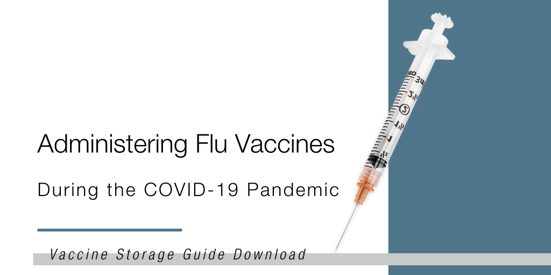
The Centers for Disease Control (CDC) has released a website page called, “Influenza (Flu): What You Need to Know for 2020-21.” This question and answer style website page covers broad topics of questions related to influenza and COVID-19, and how those two viruses will effect the upcoming flu immunization season.
This specific blog post highlights the CDC’s response to questions regarding administering flu vaccines during the COVID-19 pandemic. The information is designed for healthcare providers, but also may provide insight for patients looking to receive a flu vaccination this fall.
The following information is directly from CDC. Information is subject to change without notice.
CDC has released Interim Guidance for Immunization Services During the COVID-19 Pandemic. This guidance is intended to help immunization providers in a variety of clinical and alternative settings with the safe administration of vaccines during the COVID-19 pandemic. This guidance will be continually reassessed and updated based on the evolving epidemiology of COVID-19 in the United States. Healthcare providers who give vaccines should also consult guidance from state, local, tribal, and territorial health officials.
For the upcoming flu season, flu vaccination will be very important to reduce flu because it can help reduce the overall impact of respiratory illnesses on the population and thus lessen the resulting burden on the healthcare system during the COVID-19 pandemic.
A flu vaccine may also provide several individual health benefits, including keeping you from getting sick with flu, reducing the severity of your illness if you do get flu and reducing your risk of a flu-associated hospitalization.
What steps can healthcare personnel take to safely give flu vaccine during the COVID-19 pandemic?
The potential for asymptomatic spread of the virus that causes COVID-19 underscores the importance of applying infection prevention practices to encounters with all patients, including physical distancing (at least 6 feet) when possible, respiratory and hand hygiene, surface decontamination, and source control while in a healthcare facility. Immunization providers should refer to the guidance developed to prevent the spread of COVID-19 in healthcare settings, including outpatient and ambulatory care settings.
To help ensure the safe delivery of care during vaccination visits, providers should:
- Minimize chances for exposures, including steps such as these:
- Screen patients for symptoms of COVID-19 and contact with persons with possible COVID-19 prior to and upon their arrival at the facility, and isolate symptomatic patients as soon as possible.
- Limit and monitor points of entry to the facility and install barriers, such as clear plastic sneeze guards, to limit physical contact with patients at triage.
- Implement policies for adults and children over the age of 2 years to wear cloth face coverings (if tolerated).
- Ensure patients practice respiratory hygiene, cough etiquette, and hand hygiene.
- Ensure all staff adhere to the following infection prevention and control procedures:
- Moderate-to-substantial transmission: Healthcare providers should wear eye protection given the increased likelihood of encountering asymptomatic COVID-19 patients.
- Minimal-to-no transmission: Universal eye protection is considered optional, unless otherwise indicated as a part of Standard Precautions.
- Follow Standard Precautions, which include guidance for hand hygiene and cleaning the environment between patients.
- Always wear a medical facemask.
- Use eye protection based on level of community transmission of the virus that causes COVID-19:
- Consider these additional steps during vaccine administration:
- Healthcare providers should wear gloves when giving intranasal or oral vaccines because of the increased likelihood of coming into contact with a patient’s mucous membranes and body fluids. They should change their gloves and wash their hands between patients.
- Giving these vaccines is not considered an aerosol-generating procedure and thus, the use of an N95 or higher-level respirator is not recommended.
- If healthcare providers wear gloves when administering vaccine, they should change their gloves and wash their hands between patients.
- Intranasal or oral vaccines:
- Intramuscular or subcutaneous vaccines:
- For patients (sick or well) presenting for care or routine visits, ensure physical distancing by implementing strategies, such as:
- Separating sick from well patients by scheduling these visits during different times of the day (e.g., well visits in the morning and sick visits in the afternoon), placing patients with sick visits in different areas of the facility, or scheduling patients with sick visits in a different location from well visits (when space is available).
- Reduce crowding in waiting areas by asking patients to remain outside (e.g., stay in their vehicles, if applicable) until they are called into the facility for their appointment.
- Ensure that physical distancing measures, with separation of at least 6 feet between patients and visitors, are maintained during all aspects of the visit, including check-in, checkout, screening procedures, and postvaccination monitoring. Use strategies such as physical barriers, signs, ropes, and floor markings.
- Use electronic communications as much as possible (e.g., filling out needed paperwork online in advance) to minimize patients’ time in the office as well as their sharing of materials (e.g., clipboards, pens).
Is there guidance for giving flu vaccine in settings other than a doctor’s office (e.g., pharmacies; temporary, off-site, or satellite clinics; and large-scale influenza clinics)?
Yes. Guidance has been developed for giving vaccines at pharmacies, temporary, off-site, or satellite clinics, and large-scale influenza clinics. Other approaches to vaccination during the COVID-19 pandemic may include drive-through immunization services at fixed sites, curbside clinics, mobile outreach units, and home visits.
The general principles outlined for healthcare facilities should also be applied to alternative vaccination sites, with additional precautions for physical distancing that are particularly relevant for large-scale clinics, such as:
- Providing specific appointment times or other strategies to manage patient flow and avoid crowding.
- Ensuring enough staff and resources to help move patients through the clinic as quickly as possible.
- Limiting the overall number of patients at any given time, particularly for populations at higher risk for severe illness from COVID-19.
- Setting up a one-way flow through the site and using signs, ropes, or other measures to direct patient traffic and ensure physical distancing between patients.
- Arranging a separate vaccination area or separate hours for persons at increased risk for severe illness from COVID-19, such as older adults and persons with underlying medical conditions, when feasible.
- Selecting a space large enough to ensure a minimum distance of 6 feet between patients in line or in waiting areas for vaccination, between vaccination stations, and in postvaccination monitoring areas (the Advisory Committee on Immunization Practices recommends that providers consider observing patients for 15 minutes after vaccination to decrease the risk for injury should they faint).
Ensuring that people continue or start getting routine vaccinations during the COVID-19 pandemic is essential for protecting people and communities from vaccine-preventable diseases and outbreaks, including flu. Routine vaccination prevents illnesses that lead to unnecessary medical visits and hospitalizations, which further strain the healthcare system.
For information regarding administering the flu vaccine during a pandemic, review the Interim Guidance for Immunization Services During the COVID-19 Pandemic.
OTHER BLOGS YOU MIGHT BE INTERESTED IN...
Making Every Immunization Count
In addition to these new safety precautions and guidelines, providers need to continue following the standard vaccine storage and handling guidelines set fourth by the CDC in the Vaccine Storage and Handling Toolkit. Vaccines stored under incorrect temperatures and conditions can loose potency causing the therapy to be ineffective.
Successful influenza vaccinations are more important now than ever as the COVID-19 pandemic continues. Providers must make the most of every immunization by continuing to follow the CDC toolkit as well as following the new interim guidelines for vaccination during a pandemic.
You can download our full vaccine storage guide at the link below.




